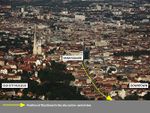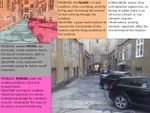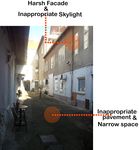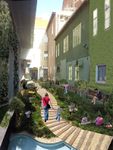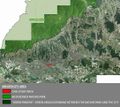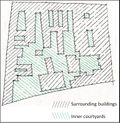Collaborative Green Infrastructure Design Group M
---> back to group page working group M
| Name | Ilica Street courtyards | |
| Location | Zagreb | |
| Country | Croatia | |
| Authors | Martina Šekutor, Masoumeh Rajabi, Esra Najjar, Ilona Feklistova | |
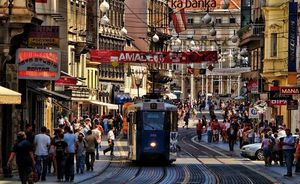
| ||
|
| ||
Landscape and/or urban context of your case
General
Ilica Street is situated in the centre of Zagreb, the capital of Croatia. It starts at the western border of the main city square and continues towards the west following the direction of a natural valley below the Medvednica mountain. It is 5660 m long and officially the third longest street in the city.
History
It is not certain how the street got its current name. At some point it used to be called Lončarska Ves (Pottery Village), because the residents used to do a lot of pottery work due to good soil and the water from the creek. However, the current name may have come from the name of the local creek or settlement, or even the type of soil underneath the settlement. The first mention of the name can be found in a document dating back to 1431, which makes it one of the oldest streets in the city.
Cultural features
There seems to be some uncertainty about how many house numbers there are along the street, but the general consensus is that they end at a number between 530 and 550, which makes it the city street with the most house numbers. It is also the reason why many people have the misconception about it being the longest street in the city.
Ilica has always had great significance in the city’s history, in the sense of its content as well as its function of connecting the eastern and western periphery of the city. It is the home of many significant historic buildings such as location where notable Croatian composer Vatroslav Lisinski was born, the buildings of respectable historic hotels (Hotel Royal, Grand Hotel, etc.) and also locations of many ˝firsts˝ (first Croatian battery factory, first Zagreb airport, etc.).
The first mentions of historic restaurants date back to the first half of the 19th century. Names such as Modroj kugli, Divljem čovjeku, Bijelom labudu, Crnom orlu, Carskom gostioničaru (loosely translated as Blue Ball, Wild Man, White Swan, Black Eagle, Imperial Innkeeper) give a sense of the era.
In 1891 it was the first street to have a street car line introduced and horse-drawn for 19 years. In 1910 the it was replaced by an electric tram.
In the middle of the 19th century it became the economy centre of the city, along with the adjacent main city square due to many respectable tradesmen shops being located there. Today, very few of those shop still exist having mostly been replaced by modern day shops, however Ilica has remained the most significant and most well known street in the city, as well as an extremely expensive residential area.
Legal status
The city developed from two neighbouring settlements, the historic towns of Gradec and Kaptol. Because Ilica developed as a suburb beneath Gradec and is a part of the historic town nucleus, it was declared a protected area in the 1960’s. Legally, it is protected as the urban compound Old Town Zagreb and listed in the National Register of Cultural Monuments. Even though it is valued as cultural heritage and classified as a zone of extremely well preserved and particularly valuable historic structure, degradation due to unorganised urbanisation could not be avoided. This level of protection is awarded to spatial and built structures of distinctive urbanistic, architectural, cultural, historic, landscape or ambiance values, significant for the image of the city and high monumental value of building substance which, as architectural heritage, defines the historic urban matrix of Zagreb.
Overall character and dinamics
The streets’ current curved shape was set in 1776 when the surrounding land was being distributed and sold so that landowners could build new houses. The buildings along the street vary in height from one to several stories. This causes the street to appear very narrow and somewhat claustrophobic.
The specific building type for this area is a closed city block with a courtyard in the centre. The street-facing facades are mostly compact and block the view towards the inside of the block, while the courtyards are mostly neglected and used for delivery vehicles, parking and waste disposal. A certain number of courtyards have some vegetation, however it is mostly not maintained or organised, giving the space an overall negative and chaotic visual character.
The street is under heavy use by residents, business-owners and employees, customers, tourists and mostly all categories of people due to its contents, central position and functions. The city alone has a population of around 790 000 people and with its wider area, which has to be considered because of daily commuters, the population increases to around 1.1 million people.
- Illustrations
What are the overall objectives of your design? What are the specific objectives for enhancing green infrastrucutre?
The objective of working on the design for this particular area was to present how unused, low quality city centre courtyards could, with the introduction of green infrastructure elements, be transformed into high quality multifunctional areas which would improve the life quality of their users as well as provide ecological benefits in a very dense, urban structure.
Analytical drawings
- Analytical Drawings
- Yourfilename3.jpg
Location C - problem analysis / Author: Esra Najjar
Projective drawings
- Projective Drawings
- Yourfilename3.jpg
Location C - projective design / Author: Esra Najjar
Design Synthesis
- Design Synthesis Drawings
Summary of the collaborative process
The potential of this kind of collaboration is the opportunity to see how other group members think and see things in their own environments and also how they learn about and approach the challenges of landscape architecture.
One of the difficulties is the fact that people are in different countries so coordinating with each other can present a bit of a challenge due to different schedules.
Image Gallery
- widths="150px"
References
Špoljarić, B., Iako ne i najduža, Ilica je ostala najvažnijom ulicom u Zagrebu, source: http://web.archive.org/web/20080213143141/http://www.vjesnik.hr/Html/1998/12/15/Zagreb.htm
Ulice koje zbunjuju poštare, spajaju parove i izluđuju susjede, Portal Jutarnji.hr, source: http://www.jutarnji.hr/ulice-koje-zbunjuju-postare--spajaju-parove-i-izluduju-susjede/319649/
Premerl, N., Ilica postaje glavna trgovačka ulica, source: http://www.mgz.hr/hr/postav/ilica/
Vremeplovom kroz Gornju Ilicu do duda nad sitnogoricom, Zagreb – Ilica (1/2) – Gornja Ilica, source: http://croatia.ch/zanimljivosti/110926.php
Po Ilici gor i dol do Zemaljske umobolnice za širi regionalni opseg, Zagreb – Ilica (2/2) – Donja Ilica, source: http://croatia.ch/zanimljivosti/110927.php
Kahlina, Z., Nepoznati Zagreb, source: http://zkahlina.ca/cro/?p=8220
Galović, K., Zagrebačka Ilica, Arhitektonsko-urbanistički razvoj, source: http://kgalovic.blogspot.com/2012/05/zagrebacka-ilica.html
Knežević, S., Zagreb: grad, memorija, art (2011): MeandarMedia Zagreb
About categories: You can add more categories with this tag: "", add your categories

